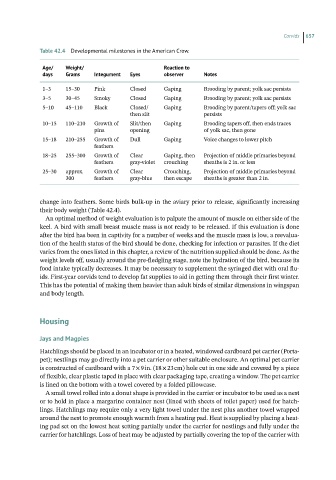Page 656 - Hand rearing birds second
P. 656
Corvids 657
Table42.4 Developmental milestones in the American Crow.
Age/ Weight/ Reaction to
days Grams Integument Eyes observer Notes
1–3 15–30 Pink Closed Gaping Brooding by parent; yolk sac persists
3–5 30–45 Smoky Closed Gaping Brooding by parent; yolk sac persists
5–10 45–110 Black Closed/ Gaping Brooding by parent/tapers off; yolk sac
then slit persists
10–15 110–210 Growth of Slit/then Gaping Brooding tapers off, then ends traces
pins opening of yolk sac, then gone
15–18 210–255 Growth of Dull Gaping Voice changes to lower pitch
feathers
18–25 255–300 Growth of Clear Gaping, then Projection of middle primaries beyond
feathers gray-violet crouching sheaths is 2 in. or less
25–30 approx. Growth of Clear Crouching, Projection of middle primaries beyond
300 feathers gray-blue then escape sheaths is greater than 2 in.
change into feathers. Some birds bulk-up in the aviary prior to release, significantly increasing
their body weight (Table 42.4).
An optimal method of weight evaluation is to palpate the amount of muscle on either side of the
keel. A bird with small breast muscle mass is not ready to be released. If this evaluation is done
after the bird has been in captivity for a number of weeks and the muscle mass is low, a reevalua-
tion of the health status of the bird should be done, checking for infection or parasites. If the diet
varies from the ones listed in this chapter, a review of the nutrition supplied should be done. As the
weight levels off, usually around the pre-fledgling stage, note the hydration of the bird, because its
food intake typically decreases. It may be necessary to supplement the syringed diet with oral flu-
ids. First-year corvids tend to develop fat supplies to aid in getting them through their first winter.
This has the potential of making them heavier than adult birds of similar dimensions in wingspan
and body length.
Housing
Jaysand Magpies
Hatchlings should be placed in an incubator or in a heated, windowed cardboard pet carrier (Porta-
pet); nestlings may go directly into a pet carrier or other suitable enclosure. An optimal pet carrier
is constructed of cardboard with a 7 × 9 in. (18 × 23 cm) hole cut in one side and covered by a piece
of flexible, clear plastic taped in place with clear packaging tape, creating a window. The pet carrier
is lined on the bottom with a towel covered by a folded pillowcase.
A small towel rolled into a donut shape is provided in the carrier or incubator to be used as a nest
or to hold in place a margarine container nest (lined with sheets of toilet paper) used for hatch-
lings. Hatchlings may require only a very light towel under the nest plus another towel wrapped
around the nest to promote enough warmth from a heating pad. Heat is supplied by placing a heat-
ing pad set on the lowest heat setting partially under the carrier for nestlings and fully under the
carrier for hatchlings. Loss of heat may be adjusted by partially covering the top of the carrier with

